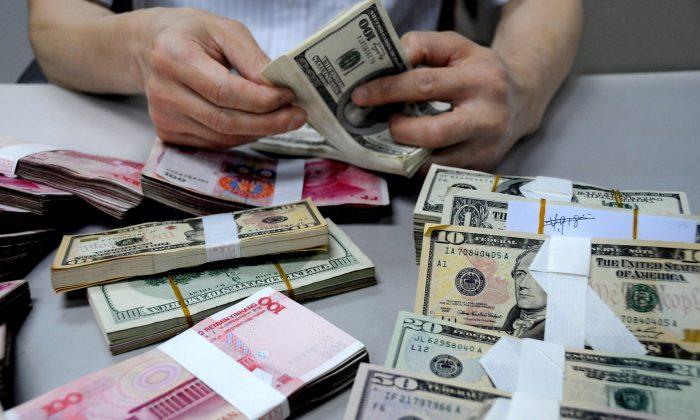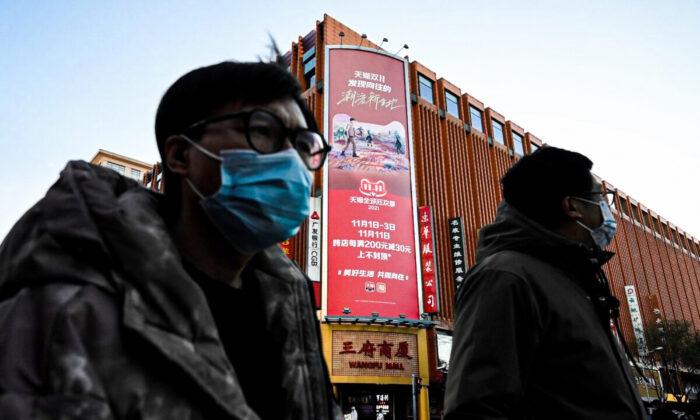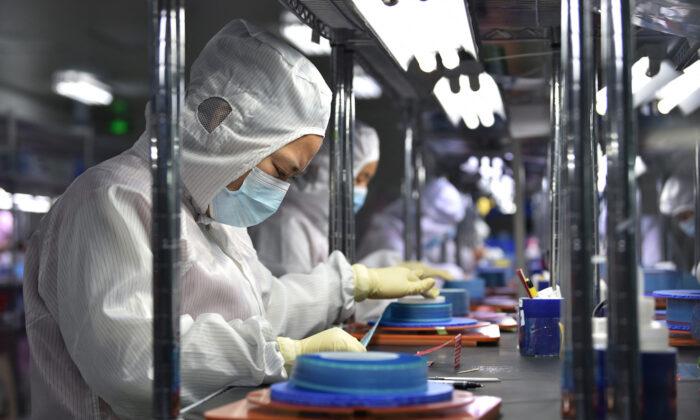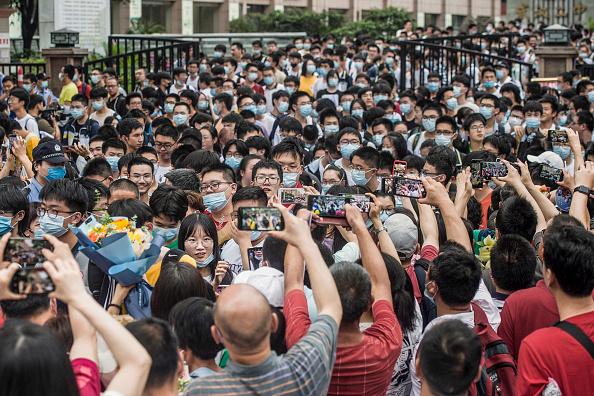China and the United States are negotiating to hold a summit in late November between presidents Trump and Xi Jinping. The U.S. government has announced publicly China’s failure to respond to Washington’s trade demands such as the guarantee of intellectual property rights. Many observers of the Sino-U.S. trade conflict assume that China has no cards to play except to stubbornly reject U.S. requests.
Yi Gang, governor of the People’s Bank of China, said at the G30 International Banking Seminar in 2018 on Oct. 14 that “we still have considerable monetary policy tools, including interest rates, required reserve ratio, monetary conditions, and other means at our disposal. The above tools are sufficient to deal with uncertainty.”
Observers either did not pay attention to Yi words, or dismissed it as a empty morale booster, like whistling to stave off ghosts when passing a graveyard. However, I believe that Yi Gang was serious. China intends to use its non-market-oriented foreign exchange management system as its last line of defense in the Sino-U.S. trade war.
Why Wasn’t China Declared a Currency Manipulator?
When the Chinese renminbi (yuan) was admitted to the IMF currency basket in 2015, China promised the International Monetary Fund (IMF) to implement financial openness and the complete convertibility of the yuan as soon as possible.(Translator’s note: The value of the Special Drawing Right (SDR) is based on a basket of five currencies—the U.S. dollar, the euro, the Chinese renminbi, the Japanese yen, and the British pound sterling.)
Today, however, the Chinese foreign exchange market still uses the exchange rate floating system that is under government control. Beijing calls it a “managed float,” which sounds better than “dirty float,” but they are essentially the same. The exchange floating of both are controlled by the government, that is, the government manipulates the exchange rate.
It was widely speculated among the Chinese public that the United States would likely declare China a currency manipulator this year. However, the “Foreign Exchange Policies of Major Trading Partners of the United States,” published by the U.S. Department of the Treasury (U.S. Treasury) on Oct. 17, said that China has remained on the “monitoring List” together with Japan, South Korea, India, Germany, Switzerland. Some media thus thought China was lucky and escaped a financial calamity.
Why is China, a country that controls the exchange rate fluctuation (which is a nicer way of saying “exchange rate manipulation”), not listed as a currency manipulator? The reasons for this are complicated.
Those familiar with Sino-U.S. relations over the past 20 years may know that until 2016, Congress had strongly criticized China for manipulating the renminbi exchange rate and demanding China be listed as a currency manipulator. There are two reasons the U.S. Treasury has refrained from doing this:
First, according to a law passed in 1988, the U.S. Treasury is obligated to conduct regular assessments of major trading partners based on three criteria to see if they manipulate their own currency exchange rates for the purpose of preventing the adjustment of international payment balances or for obtaining unfair trade advantages.
The three criteria are as follows: a trade surplus with the United States in excess of $20 billion, a current account surplus equal to at least 3 percent of GDP, and continuing state intervention in the foreign exchange market.
Between 1992 and 1994, China was regarded as a currency manipulator five times by the United States for violating all three of these standards. Since July 1994, the United States has not included any country or region in on the list of currency manipulators. President Donald Trump has been trying to list China as a currency manipulator, but because China does not fully comply with the three criteria, this cannot be done barring amendment to the existing law.
Second, due to the international economic situation, China’s control of the exchange rate is conducive to the stability of the global financial system. For instance, on Oct. 14, 2016, the U.S. Treasury not only confirmed that China was not a currency manipulator, but also positively evaluated China’s intervention in the foreign exchange market in the semi-annual report on Foreign Exchange Policies of Major Trading Partners of the United States.
The report, which was submitted to Congress, said that “China’s intervention in foreign exchange markets has sought to prevent a rapid RMB depreciation that would have negative consequences for the Chinese and global economies.”
The report said that if Beijing did not take precautionary measures, the yuan would depreciate more rapidly. This year, among emerging economies, poor and populous countries have been particularly affected by the Sino-U.S. trade war and the Federal Reserve’s interest rate hikes. As investors sold off riskier assets, from India to South Africa, the value of these countries’ currencies has plummeted. It also triggered financial crises in Turkey and Argentina. In mid-October, after the annual conference of the IMF and World Bank Group held in Indonesia, they issued a G24 statement saying that all emerging markets were adversely affected by the excessive capital flows.
China Never Intended to Marketize the Management of Foreign Exchanges
Given that the IMF cut the foot to fit the shoe in modifying the rules and allowing the yuan to be added to the IMF basket, why has it tolerated China’s failure to allow complete convertibility of the yuan — that is, why has China been allowed to continue its exchange rate controls?It is helpful to review some past events. In November 2015, when the yuan was added to the IMF currency basket, it was not in compliance with the IMF’s regulations at the time. Whether the decision was due to the IMF or the United States, political considerations were are work in letting the Chinese in. As early as April 2015, IMF First Deputy Managing Director David Lipton told Reuters that as China expected the IMF to add the yuan to the SDR, the IMF was considering adjusting its standards so that the yuan could be later added to the basket.
The matter was settled when former U.S. President Barack Obama, who holds IMF veto power, expressed support for the yuan to be added to the basket. As an important condition for the a basket currency is “complete convertibility,” the IMF specifically changed the rule for China, saying that the yuan should be able to be widely used in international trade. Of course, China also promised financial transparency and complete convertibility of the yuan at the earliest possible convenience, but it did this only so as to smooth over the negotiations. China has no intention to carry out these commitments in the short term.
In my article “The Renminbi in the Basket—a Spring Breeze Cannot Melt the Hard Ice of the System” published Dec. 4, 2015, I mentioned a long article titled ”Deepening Reform of the Financial System” written by former governor of the People’s Bank of China Zhou Xiaochuan that was published by the People’s Daily before the yuan was added to the basket. The article called for “adherence to the bottom line thinking and realization of the national financial governance system and modernization of governance capacity,” and mentioned ”establishing a national financial security mechanism to prevent systemic financial risks and effectively responding to financial attacks or sanctions from other countries in extreme situations.”
Most media in China cited Zhou Xiaochuan’s “Improve Relevant Measures to Effectively Deal with Overseas Financial Attacks“ as a way of warning against purported economic concerns. Those reports stressed that the conditions for the yuan to be added to the IMF basket are financial transparency and complete convertibility of the yuan. To carry out these commitments, China’s financial market will face risks that it did not have to content with earlier, namely, “financial attacks” by ”foreign forces.”
According to Zhou, developing countries affected by the 1997-1998 Asian financial crisis, the United Kingdom in 1993, and Japan in the 1990s had experienced this kind of “attacks.” Even the United States was not spared in the 1960s and 1970s — it is the inevitable consequence of a country’s opening itself to international trade and it is something that China must be on guard against.
Yi Gang, then deputy governor of the People’s Bank and the Director of the State Administration of Foreign Exchange, was in charge of negotiating the yuan’s addition to the IMF basket. Upon his return to China, he made a speech at the People’s Bank and publicly posted an article on Caixin called “The People’s Bank’s Briefing on the Inclusion of the Renminbi in SDR.” Some things he said were straightforward, such as “in terms of joining SDR, we did make some technical and operational reforms, or measures“ to meet the ”financial reform requirements” of the IMF.
Some of Yi’s other statements, however, were obviously designed to subtly inform the international community, particularly the IMF, of Beijing’s future plans. He said, “we are now a managed floating exchange rate system, and the future goal is to achieve a clean float of the exchange rate, which involves a transitional process. The transition should be gradual and steady to ensure that we are fully capable of maintaining the basic stability of the renminbi exchange rate at a reasonable and balanced level.”
Yi even said, “Don’t forget that the SDR will be reviewed every five years. A currency can join the SDR when it meets the conditions, and it can withdraw from the SDR when it no longer meets them” The whole speech was to tell the outside world that China will keep exchange rate fluctuations under government control for a long period of time.
On Oct.1, 2016, the IMF officially approved the yuan to be added to the basket. Three months earlier, the Chinese Communist Party (CCP) declared a “war to protect the foreign exchange reserves,” not only to control the exchange rate, but also to control the total amount of foreign exchange outflows. Many Chinese branches of foreign banks were restricted from remitting back to their headquarters their many years of foreign exchange settlements. The Chinese capital market became a one-way free-flowing capital market in which capital could flow in but not out.
The “achievement” of the “war” was to maintain the “lifeline” of China’s $3 trillion-strong foreign exchange reserves.
As described above, the Chinese regime has strayed ever further from implementing complete convertibility of the yuan, but the IMF has kept silent while the U.S. Treasury even praised China’s control of the exchange rate as contributing to the stability of the world economy.
Analysis of these past events and what is happening now shows that China’s abandoning its commitments to adhere to international standards in its management of foreign exchange management system and insisting on its own way are directly related to the fact that international organizations and the United States have purposely left loopholes for it to exploit.
The Meaning of ‘Monetary Conditions’
As a developing country, China has received many economic handicaps from the international community despite its repeated violations of international norms. This has been changing in recent years. The United States, which previously afforded China the greatest help, has decided to stop taking losses and has asked the World Trade Organization (WTO) to amend trade regulations.This was the goal of the WTO meeting held in Canada began on Oct. 24 this year. Changing the rules includes many special modifications that were created with China in mind, such as improving the notification mechanism for state subsidies and establishing clear definitions for state-owned enterprises, and the like. If the rules are successfully modified, some of the American objectives in the trade war will be achieved, such as restraining the CCP from using unfair trade practices, government subsidies in state-owned enterprises, theft of intellectual property, compulsory transfer of technology, or distortion of the international market.
It remains to be seen if the IMF would follow the WTO in amending its exceptions for China. For example, the United States might work up a rage and demand the IMF exclude the yuan from the SDR basket lest it pull the dollar out of the basket. I believe this could become a reality if Sino-U.S. relations deteriorate further, but it seems unlikely to happen for at least two or three years.
This is not because of China’s persistence, nor because the yuan’s global foreign exchange reserves rose to 1.84 percent in the second quarter of 2018 (comparable to the Australian and Canadian dollars), but because of the size of China’s foreign currency reserves.
New data released by the IMF last month shows that as of the end of June this year, the total value of foreign exchange reserves worldwide was $11.48 trillion, of which China’s foreign exchange reserves at the end of that month were $3.1 trillion, ranking it first in the world and accounting for 27 percent of the total share of global foreign exchange reserves. In the international economic system, the size of a country’s foreign exchange reserves determines its ability to maintain global financial stability.
The “monetary conditions” Yi talked about mainly referred to the huge foreign exchange reserves held by the Chinese regime. As long as China maintains its current foreign exchange management system, this card has a great effect on stabilizing its currency and economy. In 1998, this system protected China from the impact of the Southeast Asian financial crisis caused by George Soros. In the next two years, this will also become China’s last line of defense against Washington’s trade offensive.
The CCP’s non-market system has always been both a blessing and a disaster. Being accepted into the world economic system as a non-market economy, the Party has used the characteristics of this system to its benefit, which is why it refuses to give up its “Chinese characteristics” and adhere to international norms. On the other hand, this system is also the cause of the Sino-U.S. trade war. In future, due to China’s high dependence on the outside world in economics, it will be forced to open up more sectors to marketization. But we can expect state control over the management of foreign exchanges to continue for a long time.
He Qinglian is a prominent Chinese author and economist. Currently based in the United States, she authored “China’s Pitfalls,” which concerns corruption in China’s economic reform of the 1990s, and “The Fog of Censorship: Media Control in China,” which addresses the manipulation and restriction of the press. She regularly writes on contemporary Chinese social and economic issues.






Friends Read Free